Macroeconomic Coordination
An imbalance between ADF and ASF triggers a funding investment, which directly affects the demand and supply of money. Similarly, the output price adjustment is caused by an imbalance between GDP and APE. In both cases, each event triggers a change in behavior on the other, therefore, establishing strong correlations between the GDP and APE. However, under certain conditions, ADF and ASF can attain equilibrium.
While it is easy to formulate mechanisms to respond to funding investment situations, the output price adjustments cannot be addressed using simple mechanisms. The output price adjustments, therefore, require well-formulated mechanisms to implement to address any uncertainties likely to be experienced in the decision making and implementation process. It is therefore safe to implement output price adjustments after the funding adjustment is done.
Funding adjustment constitutes three categories of consumers of domestic output. Consumers with enough supply of money to buy what they have planned for fall into the first category. Consumers with a deficit of money to buy what they have planned to purchase fall into the second group, while consumers with a money supply exceeding their planned purchases are classified into the third group. Each of the consumers has distinct money supply and consumer characteristics that, however, do not qualify one to be grouped into the rich or the poor. Therefore, consumer behavior and prevalence to spend is not an appropriate index to use in qualifying one as rich or poor, but the rich and the poor all show similar consumer characteristics.
Different options exist that consumers can use to address their needs. That is in response to different consumer needs that affect each consumer in each specific group. Based on their needs, the most appropriate options are for the consumers, especially group two to borrow money in the form of loans, spend the money, and pay back the loan with interest. Consumers at this phase are unaware of the shift in the equilibrium conditions both ADF and ASF but are aware of their financial needs.
Therefore, an imbalance exists between the three groups in form of their disposable incomes. To strike a balance between the groups and address the deficits experienced by the other groups, financial institutions such as banks play a significant role in providing loans, which attract sufficient funds from the third group. However, lending money to the second group attracts interest, thus encouraging group three to lend to the banks, which is lent later to group two at an interest.
However, the demand and supply for money shifts such that the supply is not sufficient to address the rising demand. A critical situation is reached when ADF>ASF is reached. Financial institutions address the situation by raising interest rates on loans to discourage borrowing and minimize demand. Figure 1 below summarises the situation.
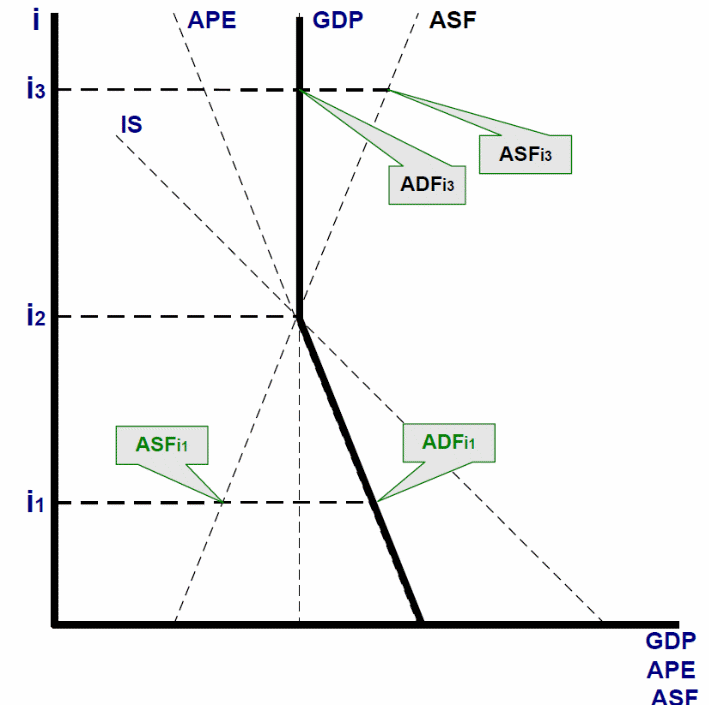
The above figure shows that changes in the GDP, APE, ASF are variably influenced by the demand and supply of money and other variables.
On the other hand, when the following relation holds ADF<ASF, there is excess liquidity reducing the demand for money. To encourage borrowing and attract customers, financial institutions lower their interest rates until equilibrium is established between ADF and ASF. Once an equilibrium position is established between ADF and ASF, the domestic output is fully funded and has a strong influence on the GDP. However, two new situations are triggered. These are GDP
Output price adjustments are triggered in any of the three situations. When demand and production are the same, when production exceeds demand, and when demand is lower than production. Firms strive to attain a situation where demand and production are sustainably the same. However, the output must be positive for a firm to experience profits when the GDP is equal to the APE and ASF. When the above situation is negative, then a firm shift to excess demand and lower production or excess production and less demand. The situation in figure 2 below is experienced.
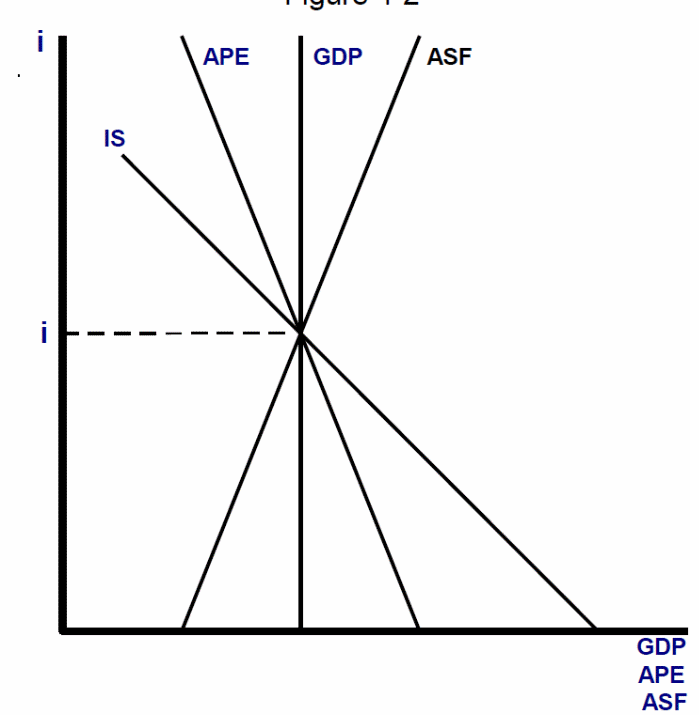
Shifting the factors to the left or the right triggers events illustrated in the above figure. Therefore, a firm has to seek an appropriate position to ensure demand and supply are balanced with profits. From the above graph, it is reasonable to conclude that when the GDP, the APE, and ASF are equal, the market conditions for the creation of jobs are not affected.
In conclusion, when demand rises, firms increase production, when demand falls; firms reduce prices to encourage consumption. However, demand and production are influenced by other factors that include the GDP, the ASP, and ADF as illustrated in graph 3 below.
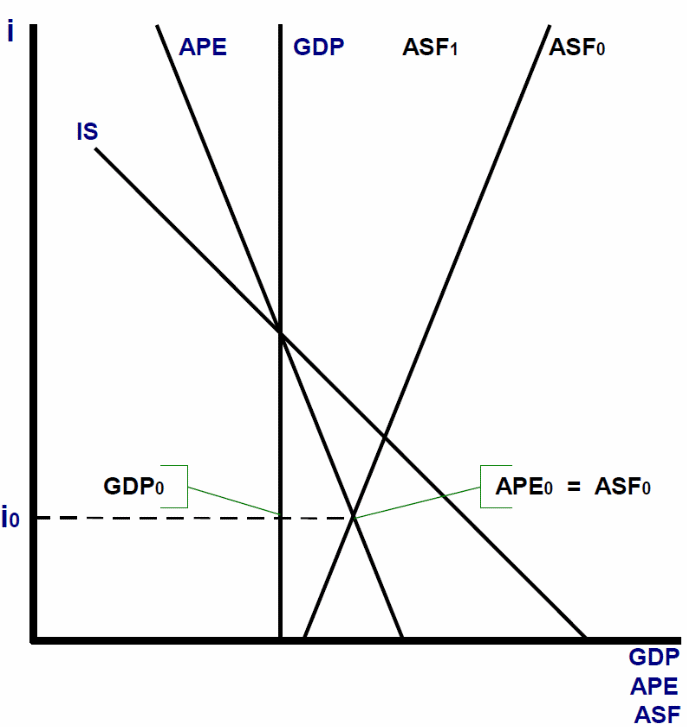
From the above graph, each firm will respond appropriately by addressing their situations, with the main aim to stay in the market with sustained profits. Therefore, each firm will either adjust the level of production to address the rise in demand for the specific product or reduce production to address oversupply or reduce production to increase demand and raise prices.
Macroeconomic Shocks
Excess Demand Cases
A macroeconomic coordination process is an event that responds to changes in GDP, APE, and ASF, with six cause and effect variables acting either in combination or entirely independent of the macroeconomic components. The macroeconomic coordination process leads to an increase in APE, ASF, or a decrease in GDP, as discussed below.
The current study considers a situation in which the three components GDP, APE, and ASF have a constant variable with multiple singular effects on each of the macroeconomic components. However, after an initial funding adjustment is done, the GDP, APE, and ASF economic components respond according to the mathematical inequality, GDP<APE=ASF. The causes and effects lead to macroeconomic equilibrium when the three components share the same quantifiable values or when they are similar.
In that situation, the economy does not experience changes in employment levels, input and outputs, and price changes. It is important to note that each of the variables causes changes in the behavior of the components according to the macroeconomic model. One of the situations that affect change is the growth based on demand referred to as demand caused expansion.
Demand caused expansion is caused by an upward shift in APE, which is demand stimulated by a rise in government or domestic consumption, or on policy implementation by the federal government to stimulate demand. On the other hand, demand might be stimulated by foreign demand for the products and goods due to several factors, which are triggered by inflation, and other market variables. However, some causes and effects are caused by the rise of a decrease in demand. In all these situations, the IS component is taken as a constant.
On the other hand, cause and effect become evident as a rise in demand for more financial investments attracts an increase in demand for money, which, according to the current situation remains constant. Though an increased demand for capital financing is experienced, the situation demands that no further lending occurs. However, the demand for further capital financing triggers a rise in interest rates through no financing is provided. This situation persists to the extent of APE=ASF. The aggregate situation is that demand is stimulated through funding, which has a ripple effect on the demand and supply of goods in the market. The situation is summarised in table 4 below.
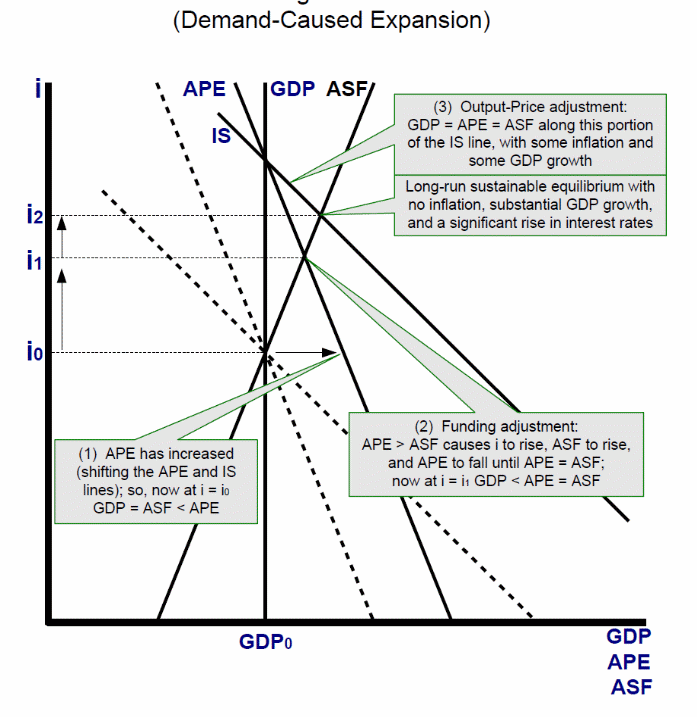
It is critical to note that initial investment funding stimulates growth that causes an increase in employment, enables firms to increase product prices, and levels of production. The situation is summarised in the statement that a shift in prices, output, and employment is experienced from a shift in APE, output price adjustment, and funding adjustment. When an intersection occurs between the three components, equilibrium is attained.
At equilibrium, an economic condition occurs in which the economy attracts higher levels of employment, output production, and price increases. Concisely, not all events trigger corresponding events. However, it important to note that leftward or rightward shifts in APE and ASF have corresponding effects on the level of interest rates, the level of production, and pricing. Prices can either be increased or decreased depending on the prevailing economic situation.
It is therefore possible to conclude that APE is directly proportional to the interest rates on funding adjustment with the funding adjustment being a constant. Initial investment funding is taken as a constant in the relationship since it applies to the initial phase of funding adjustment. Therefore, money and the supply rate are critical elements influencing an increase or changes in demand for products. However, other internal or external macroeconomic variables cause changes in the ADP, GDP, and ASF. Cost is one critical element that causes changes in economic growth, stagnation, or retardation.
The cost has a direct effect on the number of people in employment, levels of production that firms engage in, interest rates on loans, product pricing, and the operating costs firms incur. The GDP of an economy is directly proportional to a combination of the rate of employment and production levels. On the other hand, decreasing operating costs for firms has a net effect of increasing employment levels while influencing a decrease in product prices. That is explained best in figure 5 below.
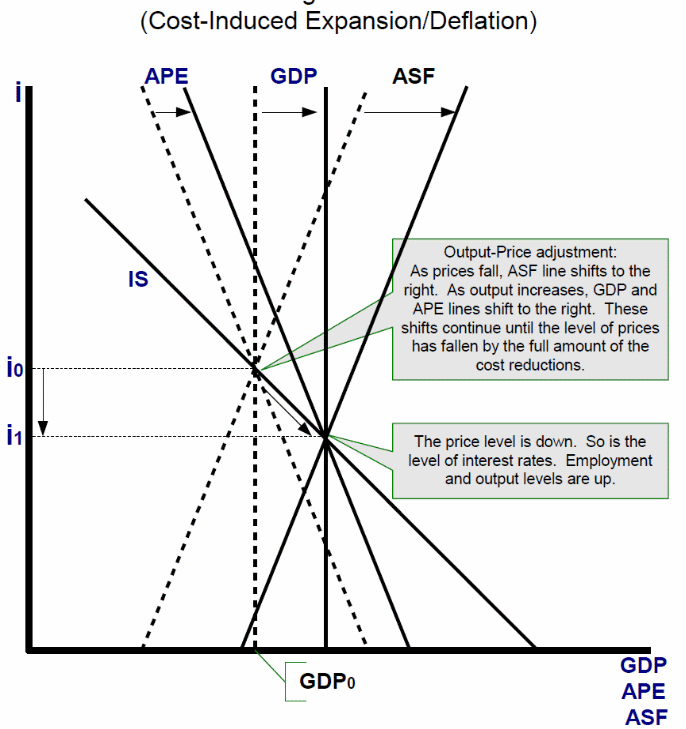
That has an aggregate effect on the general pricing of products across firms in the market. The trend is that prices reduce across the firms, but an increase in employment is experienced as a net effect. That effect is expressed mathematically in a direct relationship between deflation and its variables that include lowered prices and increased employment levels.
That is the opposite of inflation. Inflation in this case has several causes. Among them are natural calamities like earthquakes, sustained and detrimental conflicts in the labor market, and adverse effects on the economic factors of production. The aggregate effects of these adverse effects are negative effects on the GDP. That leads to higher liquidity levels that do not support factors of production, leading to inflation. However, that has a net reduction effect on interest rates, with the ripple effect on price increases and a corresponding increase in demand.
Insufficient Demand Cases
Sometimes the demand for products and services are underlying factors that cause a recession in an economy. When the demand attains a level that cannot be sustained by the normal functioning of firms, the net adverse effects on the income level of firms and a country are experienced with recession setting in. Different variables trigger a recession. These include a rise in the strength of the dollar, a decrease in demand for products and services, and low and insufficient tax reductions among others.
Recession causes a leftward shift in APE, signifying a decrease in demand for goods and services irrespective of price changes. These effects are demonstrated by changes in APE. When APE, which the aggregate or cumulative demand for goods and services is experienced, IS and APE intersect at a point showing equilibrium under the prevailing economic conditions while the GDP remains the same. The equilibrium position attained is a mathematical relationship where APE
However, when the above relation is modified by prevailing conditions so that the APE=GDP=ASP are all equal, a drop in profits is experienced, triggering a decrease in the GDP. Each of the components, APE, funding adjustment, and output price adjustments have a net effect on product and service prices, demand, and supply with ripple effects on the level of employment and profits of the firms. However, other forms of recession are likely to occur. These factors include liquidity-driven recession and credit-driven recession. Typically, therefore, firms always monitor unfolding economic events to position themselves about product demand and product pricing, and employment levels.
Another critical element to consider is the supply and demand for money and the level of liquidity in the market. Therefore, institutions such as banks that offer loans always factor the liquidity levels in the market and decide to mop up excess liquidity triggering events such as the federal government tightening monetary policies. In addition to that, the rate of supply of money into the market and the rate at which money circulates in the economy, and the transfer of money to other economies are some of the factors that influence the circulation rate.
However, in a situation where a shift in one of the factors previously in equilibrium that is GDP, APE, and ASF shifts from the equilibrium position, the net effect will be an increase in ASF, a decrease in demand, and a rise in interest rates, which is a measure to reduce excess liquidity in the market. The situation persists until APE and ASF attain an equilibrium position. This situation is illustrated in fig 6 below.
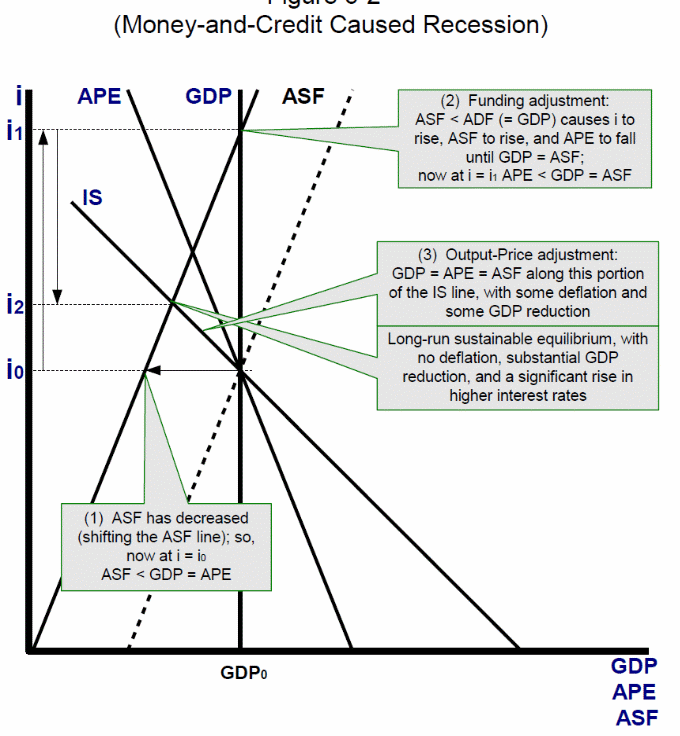
Thus, when the above monetary situations summarised in the above graph are attained, a recession is triggered based on the monetary supply and the rates of monetary circulation. Each of the factors, that is ASF and APE is characteristically lower than the GDP. However, inventory funding stimulates a rise in ASF and growth in interest rates with a corresponding decrease in APE resulting in a situation described by the mathematical inequality where APE<GDP=ASF.
The net effect will be an appreciation of interest rates, reduced employment levels. However, no growth or decrease in profits is experienced at this point, but the levels of employment, revenue in the form of profits, and prices maintain an equilibrium position. However, another form of inflation still exists. That kind of inflation is stimulated by cost and is directly related to employment levels, production volumes, product and service pricing, and interest rates.
A shift in the levels of production, prices, and production based on an economic model with cost as the common factor compel industries to adjust to the prevailing economic situations, which helps sustain profits and their operations. However, when the ASP, GDP, and APE attain an equilibrium position on the IS line, interest rates are stimulated upwards. At this point, many firms find their survival in business difficult, and naturally exit. The exit allows other firms to remain in the market and increase their share of the market. Therefore, these firms exploit the availed opportunity by increasing their product prices to address a rise in demand. the scenario is best illustrated in figure 7 below.

According to the above diagram, the cost is the underlying factor for the reduction in employment, rise in prices, and higher interest rates, referred to as inflationary recession.
Sometimes the growth of firms is negated by changes in GDP, APE, and GDY, as summarised in figure 8 below.
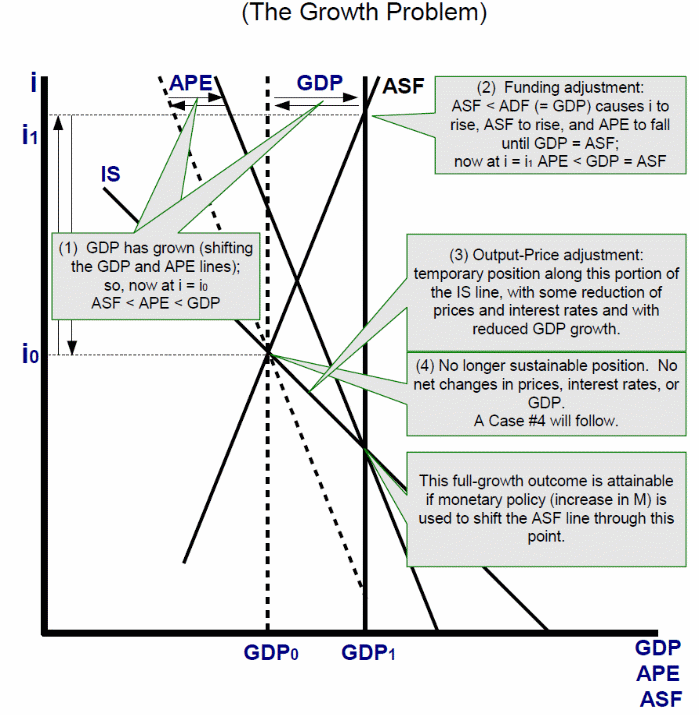
The above graph illustrates the relationship that causes a problem in growth for firms. In that case, there is a decrease in demand while activities to increase production are in the offing, triggering higher interest rates on loans. There is a positive effect on the GDP of the country. Demand is stimulated and firms adjust their factors of production to increase production. The net result is a fall in interest rates, demand, lower employment levels, reduced production, while the price factor remains constant.